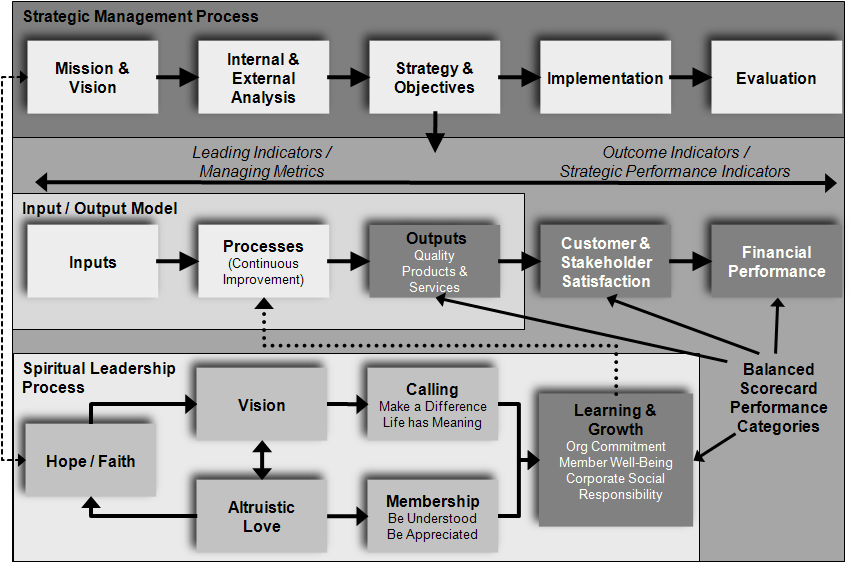As detailed in Maximizing the Triple Bottom Line Through Spiritual Leadership, the key activities that are necessary to implement the Organizational Spiritual Leadership Model include:
- Administer Organizational Spiritual Leadership Survey.
- Conduct Vision/Stakeholder effectiveness analysis with the organization’s leadership team to:
- Create a dialog for shared organizational vision/purpose/mission/values.
- Identify stakeholder effectiveness criteria and issues.
- Organize empowered teams/task forces around key issues.
- Develop and implement goals and strategies to address these issues.
- Review/develop information systems to measure stakeholder effectiveness.
- As appropriate, conduct Organizational Development Interventions and skills training in:
- Team empowerment
- Collaborative, consensus-based decision making.
- Managing conflict.
- Managing and overcoming resistance to change.
- Overcoming anger, resentment and fear through forgiveness, acceptance, and gratitude.
- Align changes with organization design variables; especially reward systems, 360 degree and stakeholder evaluations, and recruiting and selection processes. Identify those who must be asked to leave and help them exit (with love).
- Develop and implement information systems based on the Spiritual Leadership Balanced Scorecard Business Model to maximize the triple bottom line through spiritual leadership.
These practices (1) reinforce/establish organizational spiritual leadership through a vision of service to key stakeholders and a culture of care and concern based on the values of altruistic love, (2) identify key stakeholder expectations, (3) surface issues and barriers to meeting/exceeding these expectations, and (4) establish goals, strategies, and quality-based information systems to track progress on meaningful performance measures.
The Organizational Spiritual Leadership Survey and Vision/Stakeholder Effectiveness Analysis
For organizational spiritual leadership we recommend that you first administer the Spiritual Leadership Survey and then conduct a Vision/Stakeholder Effectiveness Analysis with your organizations top leadership team before undertaking any organizational change initiatives. A broad range of standardized and custom surveys and feedback reports are available for purchase online. The results of theses surveys, when combined with the vision/stakeholder effectiveness analysis, can provide tremendous insights into your organizations current level of Organizational Spiritual Leadership plus surface key issues that, if addressed, will move your organization to the next level of performance.
Take the the Organizational Spiritual Leadership Survey
Download an overview of the Vision/Stakeholder Effectiveness Analysis
Organizational Development Interventions and Skills Training
Organizational development (OD) is the planned development, improvement and reinforcement of strategies, structures, and processes that lead to organizational effectiveness. Organizational development interventions based on organizational spiritual leadership should not be initiated until the organization has established a baseline for intervention after administering the spiritual leadership survey and conducted a thorough vision/stakeholder effectiveness analysis that, in combination, identify the key issues that, if addressed, will move the organization to the next level of performance and the triple bottom line.
Common OD interventions include implementing elements of team empowerment; collaborative, consensus-based decision making; managing conflict, managing and overcoming resistance to change; and overcoming anger, resentment, worry, and fear through forgiveness acceptance, and gratitude. Finally, these changes must be aligned with key organizational design variables.
Team Empowerment
Empowerment is power sharing through the delegation of power and authority. It creates the cross-level connection between team and individual jobs and provides the basis for strong intrinsic motivation while meeting the higher-order needs of individuals. Empowered employees are more committed to the organization through trust, hope, and faith in the organization’s vision and values. In particular:
- Empowered teams receive information about organizational performance.
- Employees receive knowledge and skills to contribute to organizational goals.
- Employees have the power to make substantive decisions.
- Employees understand the meaning and impact of their jobs.
- Employees are rewarded based upon organizational performance.
Managing Conflict
Conflict pervades our daily lives. As if the workplace weren’t busy enough, research shows that managers and employees spend about 20% of their time attempting to resolve conflicts in the organization. Conflicts take many forms in organizations. There are the inevitable clashes between formal authority and power, how resources should be allocated, how the work should be done, including jurisdictional disagreements among individuals and departments. These include subtler forms of conflict involving rivalries, jealousies, personality clashes, and struggles for power and favor. Organizational conflict though is not all bad. It can be positive and seen as a constructive learning experience that creates involvement and positive relationships that lead to improved communication and problem solving. Yet it can also be a destructive force that diverts energy from tasks and widens differences creating irresponsible behavior, lower morale, with reduced commitment and productivity.
As we discuss in Maximizing the Triple Bottom Line Through Spiritual Leadership, implementing this organizational development intervention requires the team members or individuals to assess and understand their conflict style and under what conditions or circumstances a certain style is appropriate. Team leaders then model an ongoing process whereby conflict situations are acknowledged and team members are encouraged to dialogue about the conflict process and how to best resolve it.
Collaborative, Consensus-based Decision Making
The fundamental building block of a learning organization is an empowered team that encourages constructive collaboration as key to effective decision making. As we illustrate in Maximizing the Triple Bottom Line Through Spiritual Leadership, a collaborative, consensus-based process is not about reaching unanimity, but rather a situation where each party is open-minded, honest in sharing facts and opinions, and willing to participate responsibly and work toward satisfying both their and the other party’s needs. Consensus is based on the principle that every voice is worth hearing and every concern is justified. The focus here is on common ends or goals rather than differences, placing emphasis on addressing the issue rather than defeating the other party. Without consensus the quality, acceptance and the implementation and effectiveness of team decisions will suffer.
Managing and Overcoming Resistance to Change
One of the biggest problems facing today’s organizations is the failure to adapt to rapid technological and environmental change. Although there are many reasons for the failure to change and adapt, there is little doubt that effective leadership is necessary to keep change efforts moving forward. Leaders must serve as the main role model for change and provide the vision, values, and motivation to facilitate change in followers and help their organizations adapt to external threats and new opportunities. For change initiatives to succeed there must be a shared understanding of the stages in the change process and top leadership commitment to empowering employees and change teams throughout the organization to act on the vision for change.
Many good ideas are never implemented due to failure to anticipate or prepare for resistance to change because, no matter how good the idea, its implementation will conflict with some party’s interest and jeopardize current alliances in the organization. These conflicts, threats, and potential losses require strategies to increase the probability of a successful change transition. This calls for widespread communication, participation, involvement, and training (e.g., in the interventions we cover in Maximizing the Triple Bottom Line Through Spiritual leadership) to help employees understand and be enthusiastic about their role in the change process.
Overcoming Resentment, Anger and Fear through Forgiveness, Acceptance, and Gratitude
Anger, resentment and fear are the most damaging emotions in personal and professional life. They emerge when people have frustrated feelings about a past or future situation. If the spiritual leadership survey reveals that there are problems with employee anger, resentment, worry, and fear, the organization may need to emphasize interventions that target the cultural values of forgiveness, acceptance, and gratitude. This OD intervention is detailed in Maximizing The Triple Bottom Line Through Spiritual Leadership, which provides models, methods, and tools that both leaders and employees can draw upon to become free of anger, resentment, worry, and fear no matter what their circumstances.
Align Organization Design Variables
An organization will then need to focus on aligning key organizational design variables to implement any changes. The basic idea behind organizational design is that there are several key variables – structure, task, information technology, people, and reward systems – that must fit or be in alignment for an organization to implement its vision, values, goals, and strategies. A change in any one of the design variables will call for adjustments in the others as they all must form an integrated whole or system. The values that comprise the organization’s culture form the glue that holds the system. Ultimately, change is fully accepted and implemented when it is steeped in the organization’s culture and becomes “the way we do things around here.” Until the new behaviors are rooted in social norms and shared values, the organization will digress as soon as the pressure for change is removed. This stage requires that leaders make a conscious attempt to communicate how the new approaches, behaviors and attitudes have improved organizational performance. It also requires that the people and reward system design variables are adjusted so that the next generation of leaders really reflects the new order. This is where many, if not most, organizational change efforts fail. See more detail and a figure that depicts this process.
Spiritual Leadership Balanced Scorecard Business Model
The Spiritual Leadership Balanced Scorecard Business Model shown below provides framework for applying the key activities outlined above that are necessary for implementing Organizational Spiritual Leadership as well as offer a clearly defined road map for maximizing the triple bottom line.

